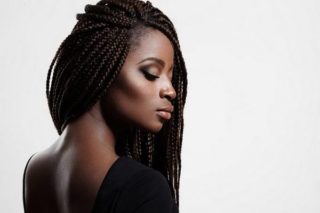The black hair care industry is worth billions worldwide. For example, the black hair care industry in the U.S. raised around $ 2.51 billio...
The black hair care industry is worth billions worldwide. For example, the black hair care industry in the U.S. raised around $ 2.51 billion in 2018. It is clear that black hair plays an important role in black culture. Unfortunately, like in the rest of the world, our worlds have been turned upside down due to a global pandemic and regulations that require us to stay at home and leave us alone for our roles.
The hair of a black woman is not just hair, but a means of self-expression, self-confidence and well-being. Now that we cannot go to the salon, we are faced with the problem of how to keep our hair inside, especially if we have never done it before.
Fortunately, it is not that difficult and the health of your roles is not at risk. Whether you have a wig, weave, braids, relaxed or natural hair, you can keep your quarantine hair healthy. All you need is a little patience and a few black hair care tips.
Natural haircuts
People with natural hair already know that natural hair requires certain products and careful care to stay healthy. 
However, if this has not been a matter of course for a long time or if you are in transition, it is understandable that you should worry about how you will take care of your roles in the coming weeks.
1. Must have tools
First of all, it is important that you have the tools that will help you take care of your hair. These essential elements are:
- A sulfate-free moisturizing shampoo
- A moisturizing conditioner
- Leave-in or butter conditioner
- Hair oil
- Unravel comb
- Shower cap made of plastic
2nd washing day
One of the best ways to keep your hair natural is an effective hair washing routine (fondly called a wash day).
Step 1: pre-shit and unravel
A typical wash day should start with your hair shitting. This is done to protect you from shampooing and reduce the risk of your hair removing moisture or its natural oils. Pre-poop can be done with hair oil or even a conditioner. Simply apply the oil or conditioner of your choice to your hair and leave it on for at least 30 minutes.
![unexplored African [live longevity]](https://www.longevitylive.com/wp-content/uploads/2019/02/accessories-afro-beautiful-935985-320x214.jpg) You can also detangle your hair before the poop. You can use a detangling brush or your fingers. When your hair is dry, it is advisable to use your fingers (as well as a detangling cream). Simply use a detangling brush for slightly damp hair. Detangling helps to remove tangles and hair that can cause knots and breaks.
You can also detangle your hair before the poop. You can use a detangling brush or your fingers. When your hair is dry, it is advisable to use your fingers (as well as a detangling cream). Simply use a detangling brush for slightly damp hair. Detangling helps to remove tangles and hair that can cause knots and breaks.
Step 2: shampoo and conditioner
A healthy scalp means happy hair. The best way to maintain a healthy scalp is to keep it clean. A sulfate-free shampoo is the best option for natural hair because sulfates can free the hair from its natural oils. How often you wash your hair every 7-10 days should help keep it clean and healthy.
That said, you should also practice washing together between your wash days. Washing the joints involves washing your hair with a conditioner or a common detergent. This provides your hair with the necessary moisture and also prevents the removal of natural oils from the hair.
Be sure to dry your hair after washing with a microfiber cloth or an old T-shirt, as a normal towel can break.
Step 3: deep conditioner
A deep care product not only moisturizes the hair, but also helps treat specific problems.
It is advisable to use a rich, creamy conditioner as this helps keep hair hydrated and super nourished. Then you need to cover your hair with a plastic cap and hold it for 30 minutes to an hour. You can also apply heat as this helps the hair absorb the product more easily.
Step 4: protein processing
To avoid protein overload, you should only receive one protein treatment every 4 to 6 weeks. 
A protein treatment not only gives your hair more volume, but also reduces breakage and prevents split ends.
3. Apply the LOC / LCO method
Moisture is one of the most important things people with natural hair struggle with. Unfortunately, natural hair is sensitive to dryness and therefore to breakage.
Therefore, it is important to moisturize the hair. One of the best ways to do this is to use the LOC / LCO method. L stands for liquid, O stands for oil and C stands for cream. This technique focuses on covering your hair with products to keep the moisture in your hair.
How can I do the LOC / LCO?
- Apply a liquid with a spray bottle. The liquid of choice can be water or a water-based humectant.
- Use a thick mixture of hair oil to trap moisture.
- Then apply a water-based cream or butter. If you have a looser curl pattern, you can choose a moisturizer. However, if you have a thicker, more curly hair type, look for hair butter.
Whether you choose LCO or LOC, the order depends on what your hair prefers. Once you've moisturized and layered your hair, the next thing to consider is protective styles.
4. Experiment with protective styles.
Now that you have free time, why not choose hairstyle tips? Protective styles are particularly important for natural hair because they protect hair from hard elements that can damage it. Braids, twists, or fabrics are examples of protective styles, as are simple hairstyles like twists and bantu knots.
 It is important that your hair is hydrated and detangled before you style it gently. If you don't know where to start, there are many YouTube channels that offer simple tutorials. Make sure you choose a YouTuber who has the same hair type as you.
It is important that your hair is hydrated and detangled before you style it gently. If you don't know where to start, there are many YouTube channels that offer simple tutorials. Make sure you choose a YouTuber who has the same hair type as you.
How about cutting my hair
Yes, it's important that you cut your hair every 4 to 6 weeks, but I don't recommend doing this if you have never done it before. Instead, examine the tips of the hair and use a pair of sharp scissors to cut a knot into a strand. Leave the rest after closing when you can finally visit your salon.
Store your handkerchiefs in quarantine
The health of your quarantined tissue really depends on the length of your stay.
If you've had it for less than a month, it's important that you try to keep it clean. Don't try to wear it all the time, but pull it into a ponytail. You can also wash it if you feel it has gotten dirty. 
However, if your tissue is over a month old, it may be time to remove it. However, if you live alone, you need to be careful when cutting the wire. It would be advisable to use manicure scissors. When you have successfully removed the tissue, wash your hair thoroughly, apply conditioner and let it breathe.
Homemade wig tips
If you trust your stylist to keep your wigs fresh and healthy, you may be a little confused. But don't worry, with a few tips you can update your quarantined wigs.
1. Keep them clean
Wigs can easily attract dust and dirt indoors. It is therefore important to keep them clean. To do this, mix a few pumps of your shampoo, argan oil and hot water in an empty container. Once you're done, put your wig in the water for a few minutes. After that, use lukewarm water to wash your wig, and then use a conditioner. This process not only helps clean your wig, but also improves its appearance.
When you have rinsed the wig with lukewarm water, wear a t-shirt to remove excess water before you let the wig dry.
2. Use a dry shampoo
Just like your real hair, you can wash your wig excessively, making your wig dry and lifeless. For this reason, it is advisable to wash your wigs every 5 to 10 uses.
 If you are concerned about the condition of your wig between washes, you can use a dry shampoo to avoid dirt and oils.
If you are concerned about the condition of your wig between washes, you can use a dry shampoo to avoid dirt and oils.
3. Cut your wig
No matter how well you take care of your wig, the ends can get damaged over time. For this reason, you should check the ends regularly and cut them if necessary.
While you are taking care of your wig, it is important to remember that your real hair under your wigs should always be your first priority. Make sure it's braided correctly and always wear a cap to protect the edges.
Pay attention to your braids when closing
When it comes to your braids, it's important not to be lazy about maintenance. 
How to keep them fresh:
- Never store your braids for longer than six weeks.
- Invest in a light, moisturizing hairspray that keeps your hair fresh and hydrated.
- To keep your hair fresh and clean, mix your regular shampoo with a little water and spray it onto your hair and scalp. Then rinse carefully or clean the scalp with a cloth.
- Wrap your braids at night with a silk scarf as this protects your hair's moisture content.
- Don't brush or pull the braids and let your scalp rest and repair itself.
- If you feel your braids are mediocre, twist the hairline beforehand.
Don't forget your edges
If your edges are weak, it is important not to tighten anything around the hairline. You can also apply hair oils like castor oil to the area to help them grow back.
Keep your hands out of your hair
When we are stressed or bored, we tend to unconsciously pull or play on our hair, which not only weakens them but can also create tension.
 For this reason, we have to find ways not to play with it. If you find that you are playing with your hair when you are anxious or bored, it is advisable to do some activities to relieve stress. This can include reading a book, teaching, or even gardening - all three keep your mind and hands away from your hair.
For this reason, we have to find ways not to play with it. If you find that you are playing with your hair when you are anxious or bored, it is advisable to do some activities to relieve stress. This can include reading a book, teaching, or even gardening - all three keep your mind and hands away from your hair.
Eat for your roles
In addition to beauty tips, it's important to remember that your hair is what you eat. So if you want to keep the coils healthy, you need to include useful nutrients in your diet.
Nutrients such as iron, protein, omega-3 fatty acids and vitamins A, C, D and B3 promote healthy hair growth. Try to include dark leafy greens, legumes, nuts, fruits, avocados, and mushrooms in your diet as this will make your mane happy. It is also important to drink plenty of water.
Would you like to know more?
Why not keep your prey in shape to keep your Afro healthy? In fact, prey exercises can keep you from sitting on your butt all day, and the good news is that there are many easy and challenging prey exercises you can do at home to keep your prey strong and strong.



